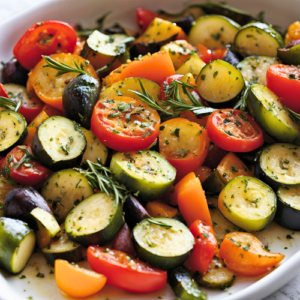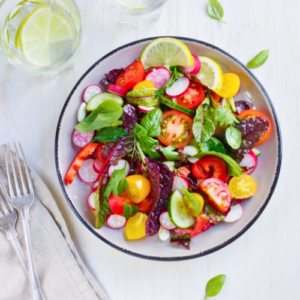From Garden to Table: Fresh Recipes Using Your Homegrown Ingredients
There’s something magical about growing your own food—watching seeds sprout into plants, tending to them with care, and finally reaping a bountiful harvest. But what’s even more fulfilling is transforming that fresh produce into delicious meals for your family. Whether you’re new to gardening or a seasoned pro, finding garden to table recipes that highlight your homegrown vegetables and herbs is the perfect way to enjoy the fruits of your labor.
In this guide, we’ll explore creative and healthy ways to turn your fresh garden ingredients into mouthwatering dishes. From fresh recipes for dinner to vegetarian options and the benefits of cooking with fresh herbs, you’ll learn simple techniques to enhance the flavors of your homegrown produce. At DIYDalia’s, we believe in the power of “Innovate, Create, and Elevate,” and we want to show you how to do just that with your garden-to-table meals.
Why Cook with Fresh Garden Ingredients?
There’s no substitute for the taste of fresh ingredients harvested straight from your backyard. Not only are they more flavorful, but they are also packed with nutrients. Cooking with fresh herbs versus dried allows you to experience the full flavor spectrum that herbs like basil, mint, and thyme have to offer. Fresh herbs provide a burst of freshness that can transform even the simplest dish into something extraordinary.
When you rely on your own garden, you know exactly what’s going into your food—no chemicals, no preservatives—just wholesome, organic ingredients. This can significantly enhance the health benefits of your meals and elevate your everyday cooking.
Health Benefits of Using Fresh Ingredients
Growing your own food and using it in healthy recipes doesn’t just help your body—it benefits your mind and the planet too. Gardening is a physical activity that promotes overall wellness, and when you cook your garden-fresh ingredients, you’re supporting a sustainable and eco-friendly lifestyle. Storing your food also cuts down on food waste and encourages a self-sufficient lifestyle, keeping you connected to the earth and your food sources.
Materials You’ll Need for Your Garden-to-Table Recipes
- Fresh vegetables and herbs from your garden (tomatoes, cucumbers, zucchini, mint, basil, etc.)
- Kitchen shears or a herb-cutting tool
- Fresh ingredients like olive oil, salt, pepper, garlic, and lemon
- Cutting board
- High-quality kitchen knife
- Large mixing bowls
- Measuring cups and spoons
- Baking sheets
- Pots and pans for stovetop cooking
- Fillable tea bags (for herb-based teas)
- Mason jars for herb storage
- Labels to mark your preserved herbs and sauces
Please Note: This post contains affiliate links, which means I may earn a commission if you make a purchase through these links. Your support helps keep this content free. Thank you for your understanding and support!
Easy Garden-to-Table Recipes
Here are some farm fresh recipes to help you make the most of your harvest and bring vibrant, seasonal meals to the table.
 Garden-Fresh Herb Salad
Garden-Fresh Herb Salad
This salad is as fresh as it gets, and it’s incredibly simple to make! Gather a variety of greens from your garden like arugula, spinach, and kale, along with herbs like mint and basil.
Ingredients:
- 2 cups mixed greens (arugula, spinach, or kale)
- 1/4 cup fresh mint leaves
- 1/4 cup fresh basil leaves
- 1 cucumber, thinly sliced
- 1/4 red onion, thinly sliced
- 1/4 cup feta cheese (optional)
- 2 tbsp olive oil
- Juice of 1 lemon
- Salt and pepper to taste
Instructions:
- Wash and dry your greens and herbs thoroughly.
- In a large bowl, combine greens, mint, and basil.
- Add the cucumber, red onion, and feta cheese if using.
- Drizzle with olive oil and lemon juice.
- Toss gently and season with salt and pepper.
This light and refreshing salad is perfect for warm days and highlights the flavors of fresh herbs. Plus, it’s versatile—feel free to add more veggies depending on what’s growing in your garden!
 Roasted Garden Vegetables with Fresh Herb Dressing
Roasted Garden Vegetables with Fresh Herb Dressing
Nothing beats roasted veggies, especially when they’re fresh from the garden. This dish can be customized with whatever vegetables you have on hand—tomatoes, zucchini, carrots, or even potatoes.
Ingredients:
- 1 zucchini, sliced
- 2 tomatoes, halved
- 2 carrots, chopped
- 1 bell pepper, sliced
- 1/4 cup olive oil
- 1 tbsp fresh rosemary, chopped
- 1 tbsp fresh thyme, chopped
- Salt and pepper to taste
Instructions:
- Preheat your oven to 400°F (200°C).
- Place all your vegetables on a baking sheet and drizzle with olive oil.
- Sprinkle with rosemary, thyme, salt, and pepper.
- Roast in the oven for 20-25 minutes, or until tender and golden brown.
Tip: You can save roasted tomatoes by freezing them. Simply cool the tomatoes, place them in a freezer-safe bag, and they’ll be ready to add to soups or sauces later.
Vegetarian Herb Pasta
Looking for a fresh recipe for dinner that’s both satisfying and packed with flavor? This vegetarian pasta is simple to make and incorporates a variety of fresh herbs to create a rich and aromatic sauce.
Ingredients:
- 12 oz of your favorite pasta
- 1/4 cup fresh basil, chopped
- 1/4 cup fresh parsley, chopped
- 2 cloves garlic, minced
- 1/4 cup olive oil
- 1/2 cup cherry tomatoes, halved
- Salt and pepper to taste
Instructions:
- Cook the pasta according to package instructions.
- In a pan, heat olive oil and sauté garlic until fragrant.
- Add the cherry tomatoes and cook until they soften.
- Stir in the fresh herbs and cooked pasta, tossing to combine.
- Season with salt and pepper, and enjoy!
Homemade Pesto with Basil
One of the best ways to use an abundance of fresh basil is to make homemade pesto. This versatile sauce can be used on pasta, sandwiches, or as a dip.
Ingredients:
- 2 cups fresh basil leaves
- 1/4 cup pine nuts
- 2 cloves garlic
- 1/2 cup grated Parmesan cheese
- 1/2 cup olive oil
- Salt and pepper to taste
Instructions:
- Combine basil, pine nuts, garlic, and Parmesan in a food processor.
- Pulse until finely chopped.
- While the food processor is running, slowly drizzle in the olive oil until the mixture is smooth.
- Season with salt and pepper to taste.
Store your pesto in an airtight container in the refrigerator, or freeze it in ice cube trays for easy portioning!
Mint & Lavender Herbal Tea
Herbs like mint and lavender can be dried and used to make homemade teas, providing a soothing beverage to sip on year-round. This step-by-step guide will help you create a refreshing tea blend with your own herbs.
Ingredients:
- 2 tbsp dried mint leaves
- 1 tbsp dried lavender flowers
- Fillable tea bags
Instructions:
- Dry your herbs using a low-temperature oven method, or air dry them naturally.
- Once fully dried, mix the mint and lavender in a bowl.
- Spoon the mixture into fillable tea bags.
- Steep in hot water for 5-7 minutes for a relaxing and fragrant tea.
Summer Salad with Fresh Basil and Lemon Dressing
Basil and Lemon Dressing
Looking for a summer recipe with fresh herbs? This basil and lemon dressing brings out the best in summer veggies like cucumbers and tomatoes.
Ingredients:
- 2 cucumbers, sliced
- 4 tomatoes, chopped
- 1/4 cup fresh basil leaves
- 2 tbsp lemon juice
- 1/4 cup olive oil
- Salt and pepper to taste
Instructions:
- Combine cucumbers, tomatoes, and basil in a large bowl.
- Whisk together lemon juice, olive oil, salt, and pepper.
- Pour the dressing over the veggies and toss to coat.
Tips for Cooking with Fresh Herbs
- Use herbs early and often: Herbs like basil, parsley, and cilantro are best when added at the end of cooking, while rosemary and thyme can handle longer cooking times.
- Try pairing herbs with different vegetables: Mint pairs beautifully with peas, while dill works wonders with cucumbers. Get creative!
- Don’t overdo it: A little goes a long way with fresh herbs. Start with a small amount and adjust to taste.
Fresh vs. Dried Herbs
When comparing cooking with fresh herbs versus dried, remember that fresh herbs are more delicate and have a more vibrant flavor. Dried herbs are concentrated, so you’ll need less of them—generally one-third of the fresh amount called for in recipes.
Basil-Infused Olive Oil
If you’re looking for another way to use up your basil, basil-infused olive oil is a perfect option. It’s a fantastic way to preserve the flavor of your herbs and use it year-round.
Ingredients:
- 2 cups fresh basil leaves
- 1 cup extra-virgin olive oil
- Pinch of sea salt
Instructions:
- Bring a small pot of water to a boil and prepare an ice bath.
- Blanch the basil leaves in boiling water for 10 seconds, then transfer them immediately to the ice bath.
- Once cool, pat the basil leaves dry.
- In a blender, combine the basil, olive oil, and sea salt, and blend until smooth.
- Strain the mixture through a fine-mesh sieve or cheesecloth into a clean jar.
- Store your basil-infused olive oil in the refrigerator for up to a month.
Pro Tip: Use this flavorful oil in salad dressings, drizzle it over pasta, or dip freshly baked bread in it.
Basil and Tomato Bruschetta
Fresh tomatoes and basil are a classic combination that sings during the summer. This easy-to-make bruschetta is perfect for a light appetizer or snack.
Ingredients:
- 4 ripe tomatoes, diced
- 1/4 cup fresh basil leaves, chopped
- 2 garlic cloves, minced
- 2 tbsp extra-virgin olive oil
- 1 tbsp balsamic vinegar
- Salt and pepper to taste
- French baguette, sliced and toasted
- Mozzarella pearls
Instructions:
- In a medium bowl, combine the diced tomatoes, basil, garlic, olive oil, and balsamic vinegar.
- Season with salt and pepper to taste.
- Spoon the tomato mixture onto toasted baguette slices.
- Add Mozzarella.
- Serve immediately and enjoy the burst of fresh flavors.
Lemon Basil Ice Cream
Yes, you read that right—herbs aren’t just for savory dishes. Lemon basil ice cream is a refreshing dessert that offers a unique blend of zesty and herbal flavors.
Ingredients:
- 1 cup fresh basil leaves
- 2 cups heavy cream
- 1 cup whole milk
- 1 cup sugar
- Zest of 1 lemon
- 4 large egg yolks
- Juice of 1 lemon
Instructions:
- In a medium saucepan, heat the milk, cream, and lemon zest over medium heat until just simmering.
- Remove from heat, add the basil leaves, and let steep for 30 minutes. Strain and discard the basil leaves.
- In a separate bowl, whisk together the egg yolks and sugar until pale and fluffy.
- Slowly pour the warm milk mixture into the eggs, whisking constantly.
- Return the mixture to the saucepan and cook over low heat, stirring constantly, until it thickens and coats the back of a spoon.
- Remove from heat, stir in the lemon juice, and cool completely.
- Pour the mixture into an ice cream maker and churn according to the manufacturer’s instructions.
Pro Tip: Garnish with a few fresh basil leaves or a lemon wedge for an extra burst of flavor.
Cooking with Homegrown Ingredients: A Final Thought
Bringing your garden harvest into your kitchen doesn’t just result in fresher meals—it allows you to experience a deeper connection to your food and the effort that went into growing it. The joy of plucking herbs and vegetables directly from the garden and incorporating them into fresh, flavorful dishes is both rewarding and satisfying. There’s no better feeling than transforming your homegrown produce into nutritious, flavorful meals. With these garden to table recipes, you can bring the bounty of your garden directly to your dinner table. Whether you’re making a light herb salad, roasting vegetables, or whipping up a quick pasta dish, your garden-fresh ingredients will shine through.
Whether you’re making a batch of homemade pesto, infusing olive oil with fresh basil, or preparing a garden-fresh salad, each dish is a testament to the hard work and care you’ve invested in your garden.
With these recipes and tips, we hope you feel inspired to create meals that not only nourish your body but also highlight the beauty of your garden. From summer salads to refreshing herbal teas, the possibilities are endless when you grow and cook with your own fresh ingredients.
Related Posts from DIYDalia’s Blog:
- Preserving Your Garden Vegetables: Tips, Tricks, and Techniques for Long-Lasting Freshness
- The Essential Guide to Gardening: Start Your Garden from Scratch and Watch It Flourish
- From Frustration to Flow: Why Drip Irrigation is the Perfect DIY Project for Your Garden
- Build Your Own Stunning Garden Trellis with a Cattle Panel (In Just a Few Hours!)
At DIYDalia’s, we’re passionate about empowering you to “Innovate, Create, and Elevate” your home and garden projects. Whether you’re a beginner gardener or an experienced home cook, we hope this post helps you savor the harvest of your hard work. Happy gardening and cooking!
Sign up to the newsletter
Powered by EmailOctopus





